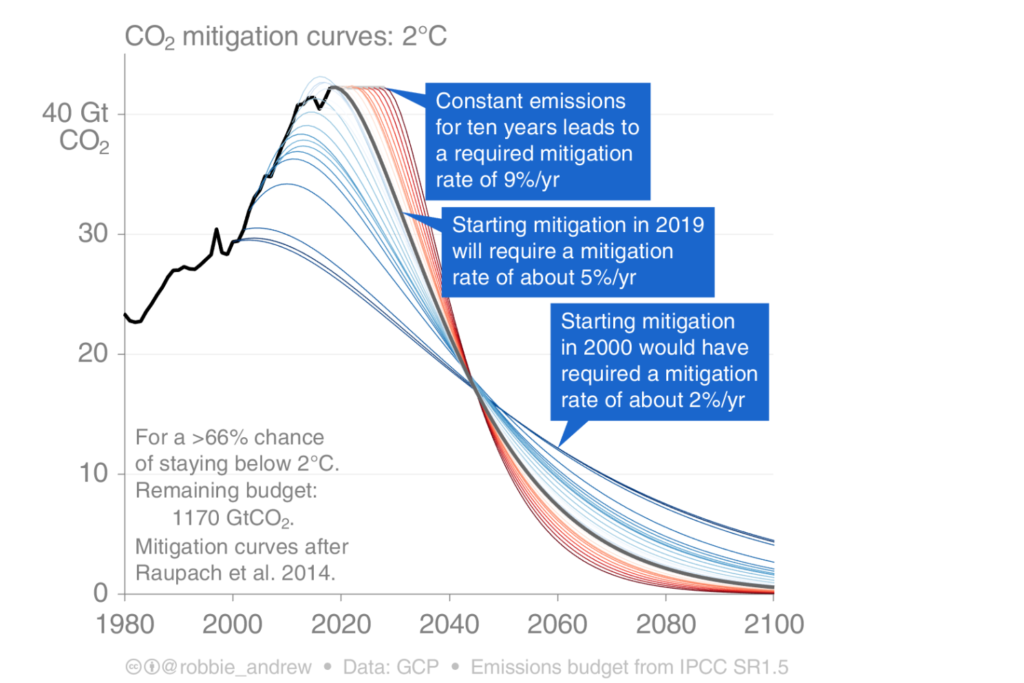If you’re involved in sustainability, you’ve probably been reading a lot about COP26 recently. The 26th UN Climate Change Conference of the Parties — better known by its abbreviation, COP26 — convened in Glasgow in late October and ended on Friday, November 12. Over 40,000 attendees, including roughly 120 heads of state and national representatives, came together to outline their climate commitments and make new pledges. Some of the numbers are staggering. One number I heard anecdotally was that there were over 300,000 different pledges made at the conference, some of which contain astounding figures like $130 trillion for “transforming the economy for net zero”.
COP26’s first goal was to “secure global net zero by mid-century and keep 1.5 degrees within reach,” and the various participants were clearly ready to back that goal with financial commitments. But despite the optimism inspired at the conference, many remain skeptical, and rightly so. Ugandan climate activist Vanessa Nakate reminded the audience that promises alone will not stop climate change, and “immediate and drastic action” is needed. Greta Thunberg went even further, stating that COP26 was “sort of turning into a greenwash campaign.”
That may be an overly cynical interpretation, but even if we optimistically expect all the net zero promises from the conference to be fulfilled, that still may not be enough to achieve the desired climate goals. A report from Climate Action Tracker found that even with these pledges, emissions will still be twice as high as they need to be to meet the 2030 1.5 degree target. It’s a stunning finding given the scale of the pledges, but that’s how big of a hole we’ve dug ourselves when it comes to climate change.
So it leaves us with no choice: we need an overshoot strategy. More specifically, we need to do so by moving toward net negative pledges. And we need to execute on this right now.
We’ve already seen the perils of waiting until later to act. In 1988, the unforgettable Dr. James Hansen of the NASA Goddard Space Institute gave testimony on climate change to the U.S. Senate Committee on Energy and Natural Resources. If we had acted on Dr. Hansen’s testimony at the time, we would have been able to decarbonize our societies at a rate of around 2% a year, giving us about a two-thirds chance of limiting warming to no more than 1.5°C by 2030. Things aren’t so rosy now — as shown in the chart below, the steeper (and less possible) the mitigation curve becomes.

If we’re already at a point where net zero efforts won’t achieve the mitigation we need, we have little choice but to go further. Net negative is an aggressive, action-oriented climate strategy that brings an overshoot mentality to the table, one that can help us move past net zero commitments being the status quo. As the name suggests, net negative means absorbing more climate-changing emissions each year than you produce. Temperatures would be allowed to go beyond 1.5°C in the near term, but then be brought down with a range of carbon dioxide removal by the end of the century.
Net zero, while still important in setting the industry standard and providing a blueprint for climate action, should be taken as a framework, not a commitment. Within a few decades, we will need to transform our civilization from one that currently pumps out 59 Giga tons of carbon dioxide into the atmosphere each year, to one that produces a net removal of tens of billions. This will require not only a shift to net negative, but frequent checks and balances, course correction, milestone reporting, and more.
So how can we as business leaders take action towards this goal of net negative carbon emissions? It’s important to know we’re not doing it alone, and there are plenty of other examples to follow. Last year, Microsoft announced its plans to be carbon negative by 2030 — emphasis on the word “plans,” as their announcement notes, “We recognize that progress requires not just a bold goal but a detailed plan.”
In fact, Microsoft’s president Brad Smith likened the race to build climate tech to JFK’s plan to go to the moon. Microsoft is focusing on carbon removal and other climate technologies by pledging to remove ALL carbon since its founding in 1975.
“I wouldn’t call it a gamble. But it’s fair to call it a bet. We are betting on the future.”, said Smith in an interview with BBC during COP26.
Bracken Darrell, Logitech CEO, also recently announced that the company will be “climate positive” by 2030. This is one of the most aggressive commitments by a large manufacturer.
Intuit serves as yet another example. Earlier this year, they announced a goal of not simply achieving carbon neutrality, but surpassing it by 50%. And it’s not just private companies either — government bodies are also laying out guidelines for addressing embodied carbon.
I’ll leave you with a few guidelines that McKinsey published at the conclusion of COP26, examining the fact that commitments for net zero are generally outpacing our current abilities to hit those commitments (such as “formation of supply chains, market mechanisms, [and] financing models.” While these recommendations are made for net zero, the same principles apply for net negative — they are so pertinent that I want to highlight them here:
Such plans will vary in their specifics, of course, but well-formed ones will feature certain elements:
1. emissions targets for Scopes 1, 2, and 3 (the hardest to meet); these should include long-term targets, as well as near-term goals for 2025 and 2030, all aligned with science-based mitigation trajectories or sector-specific trajectories from credible authorities
2. a strategic view of climate risks and opportunities for each part of the company’s portfolio, covering both competitive dynamics and environmental exposures
3. an assessment on the spending of transition capital that will be required to reduce emissions, especially from existing emissions-intensive assets, coupled with a credible stance on the use of high-quality carbon credits
4. a program for building capabilities to monitor external conditions, make decisions about how to update the company’s plan, and implement it
Now is the time to act on the momentum from COP26 — it may sound like a paradox, but the most (climate) positive action we can take is to start aiming to be (carbon) negative.



